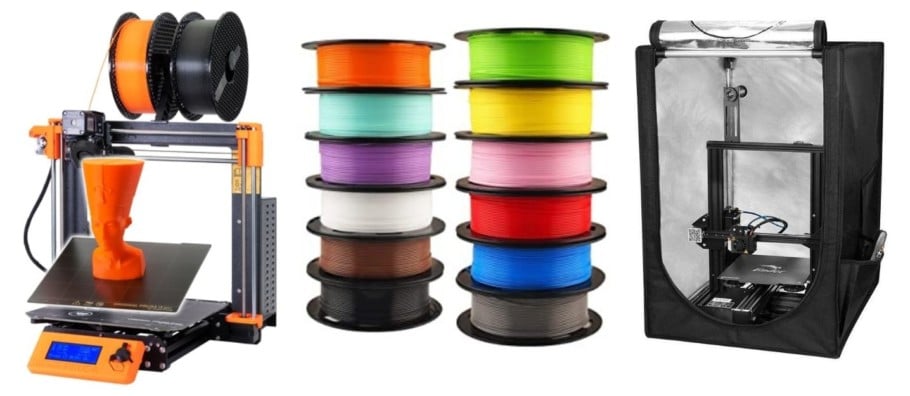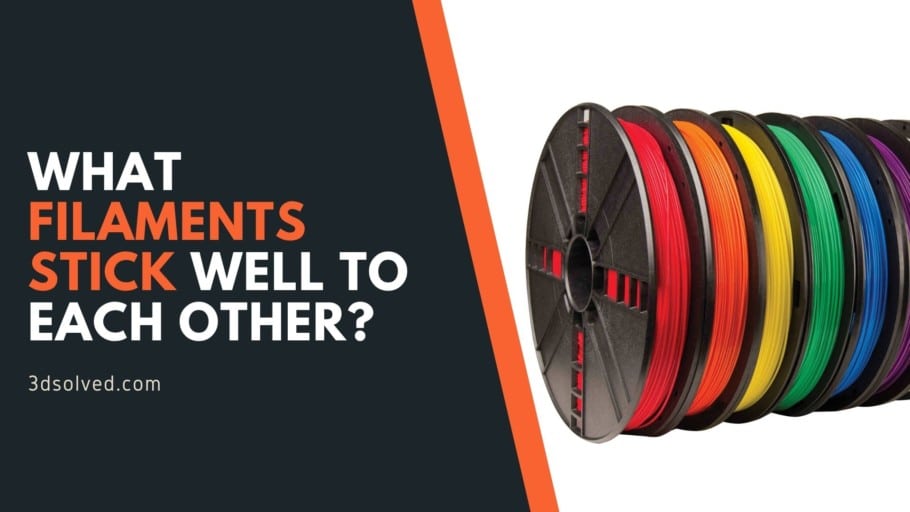In this article, I will go over some of the most-used filaments, such as PLA, ABS, TPU, PETG, etc., and tell you which ones can be combined in the same print.
In addition to this, I will give you a short list of what filament types can be used as supports for others, since there may be certain scenarios where you’d might want to use PETG as a support material for ABS, for example, since it won’t create as strong of a bond, making the support removal easier.
This is a FAQs-style article, so just scroll down to the question you need answered!
So, without any further ado, let’s get started!
Will PLA stick to PETG?
PLA will most definitely stick to PETG but the bond between the two layers will be quite weak and won’t survive most mechanical stress, which means that printing functional objects from PLA and PETG combined is not recommended since they will be quite weak. For more aesthetic prints that don’t need to withstand much force, the combination of PLA and PETG should work just fine.
Tip: if you encounter any problems and the filaments don’t stick, try slowing down the print speed. This is what worked for me and I don’t see a reason that it shouldn’t work for you as well.
Will PLA stick to ABS?
PLA will most definitely stick to ABS and the bond between them will be quite strong, even if you subject them to a strong mechanical stress and try to pull them apart, the two materials should be able to withstand it. The bond won’t be as strong as just printing with one filament, but it’s definitely doable.
Tip: if you print ABS on top of PLA and aren’t using a heated bed, then in order to avoid excess warping, you will have to print ABS slowly.
Will PLA stick to TPU?
PLA will bond with TPU without too many issues, but the bond won’t be too strong, which is why PLA is often used as a support material for TPU prints since it’s quite easy to remove. However, for mechanically intensive purposes, PLA won’t create a strong enough bond with TPU.
Tip: While printing TPU set retraction to zero to avoid clogging.
Will ABS stick to PETG?
ABS will most definitely stick to PETG with ease. However, the bond between the two plastic types will be quite weak, so I wouldn’t recommend printing models out of ABS and PETG that may be subjected to a lot of physical stress.
Tip: Take advantage of the fact that the bond between ABS and PETG is weak and both can be separated easily, which means that you can use PETG, for example, as a support material while printing with ABS.
Will TPU stick to PETG?
TPU will stick to PETG and the bond between TPU and PETG will be moderately strong, since they will only separate under strong mechanical stress and there’s even a chance that PETG will just break before it detaches from the TPU.
Will TPU Stick to ABS?
TPU will most definitely stick to ABS without too much trouble, and the bond between TPU and ABS will be moderately strong but not so strong that it may end up being difficult to separate them and cause damage.
Tip: Make sure the retraction is set to zero when printing TPU.
What Filaments work as supports for other filaments?

Supports are not part of the model, their only purpose is to prevent gravity from pulling down the complex parts of your model while it is being printed and completely ruining it. Once the print is finished, the supports should come off easily without damaging the surface of the model. Hence, it’s a good idea to use filaments that create weaker bonds overall as supports, and this way you will have an easier time removing them.
I also use rectilinear infill to assist me in this as they swap direction every layer. Theoretically, If the angle between the supporting layer and interface layer is 90°, it will make it easier for the supports to be removed. Because a smaller contact area between layers will result in a weaker bond.
PLA Supports

PLA supports for PETG
PLA will be suitable to print supports for PETG models because they both stick to each other easily and the bond is quite weak, which is the ideal scenario.
PLA supports for ABS
PLA sticks too well to ABS and the bond is quite strong. Hence, if you use force to remove PLA supports you may just end up damaging the ABS model.
Instead, dip the model in sodium hydroxide solution heated at 80C and leave it there for a couple of hours. PLA supports will just dissolve in the solution and ABS won’t react at all with the sodium hydroxide solution.
Another thing to keep in mind is that if you aren’t using a heated bed, you will have to print slowly so ABS doesn’t warp.
PLA supports for TPU
It is generally a good idea to print PLA supports for TPU prints. They bond well, and though the bond can be considered moderately strong, it is still fairly easy to remove PLA supports without damaging the print by just pulling them apart.
ABS Supports

ABS supports for PETG
ABS supports are a great choice for PETG prints because the bond between the two is quite weak, and this is also the reason that PETG can be used as the raft material when printing with ABS, since the two will be very easy to separate without damaging the model.
ABS supports for PLA
ABS sticks to PLA too well, and any attempt to separate the two materials may damage them. In theory, you can print ABS supports for PLA and then use acetone, which is a powerful solvent to dissolve ABS. But depending on the brand or type of PLA you are using, acetone can also affect PLA and ruin the print.
ABS supports for TPU
ABS adheres to TPU but the bond is only moderately strong, so it is easier to detach the ABS supports by applying a little force without damaging the print. This means that ABS can definitely be sued as a support material when printing with TPU.
PETG Supports

PETG supports for ABS
It is always a great choice to use PETG supports for ABS models because the bond between the two materials is fairly weak and PETG supports can be easily removed without damaging the ABS print by just pulling them apart.
PETG supports for PLA
PETG supports are a good choice for printing PLA prints because the bond between them is very fragile. Hence, PETG supports can be removed fairly easily without damaging the actual print. Additionally, PETG can also be used as the Raft material when printing with PLA.
PETG supports for TPU
PETG supports can be used for TPU prints since the bond between PETG and TPU is moderately strong, but PETG supports can be removed using pliers, but you have to be careful not to damage the TPU print.
HIPS Supports

HIPS supports for PLA
HIPS can be dissolved using Limonene, and since it adheres fairly well to PLA, it can definitely be used as a support material. Once the print is finished, submerge it in Limonene and wait for the HIPS to dissolve until only the PLA print remains.
HIPS supports for ABS
ABS and HIPS both stick to each other well and the bond is fairly strong. Hence, it will be a good idea to use HIPS supports for ABS prints because once the print is finished, you can use Limonene to dissolve HIPS and it won’t affect your ABS print (as long as ABS is not exposed for too long to the Limonene, which is why it’s recommended to do this mostly with smaller prints, since the HIPS supports will dissolve quickly).
Conclusion
There’s definitely a number of filaments that can work well when printed in combination with another one, but you may need to adjust the temperature, printing speed, etc. to succeed.
In most cases, I’d recommend using one material for the actual print and the other one for supports, since this should make the removal of said supports much easier and lower the risk of damaging the print.
Check out our recommended products section

We created a recommended products section that will allow you to remove the guesswork and reduce the time spent researching what printer, filament, or upgrades to get, since we know that this can be a very daunting task and which generally leads to a lot of confusion.
We have selected just a handful of 3D printers that we consider to be good for beginners as well as intermediates, and even experts, making the decision easier, and the filaments, as well as the upgrades listed, were all tested by us and carefully selected, so you know that whichever one you choose will work as intended.
Error processing API data.

Hi Facundo,
thanks a lot for your article about what filaments stick well to each other. I’d like to ask you, which 3D printer can you recommend for printing different materials (e.g. TPU and PETG) in one print job? So far, I have only seen systems like e.g. the Prusa Multi Material printer, which uses the same extruder for all materials and I am wondering whether this actually works with a printer like that because of the different necessary melting temperatures. I think printing different materials is not like printing the same material just in different colors, but it seems to me, that most multi-material FDM printers are only capable of doing the later point but not the first one. Can you please help me here with your expertise?
Best greetings
Johannes
I use Prusa i3 to print PETG parts that have a TPU face. Slice with settings for PETG, but change bed temp to 50° and slow the TPU solid layers down to 20mm/s max. I do 3 or 4 solid TPU layers and when the infill layers start, insert color change in prusaslicer so it will pause and you can swap the filaments to finish in TPU. Gives the line-free finish and perfect adhesion of TPU on a textured bed with the strength and lower cost of PETG.